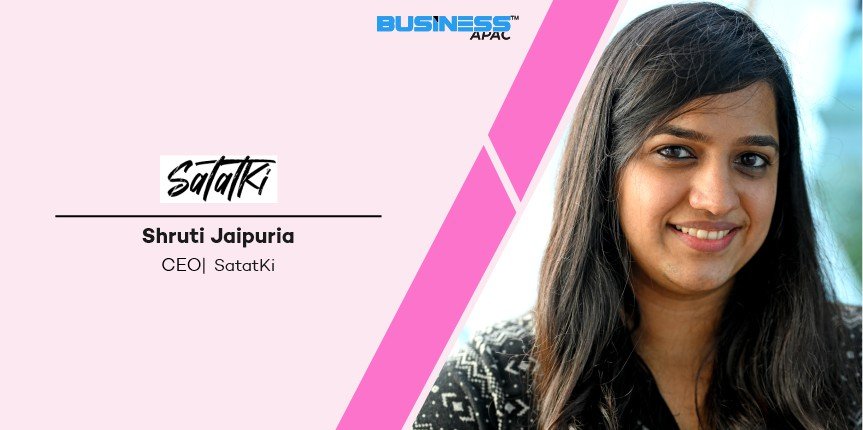The fashion industry is an enormous sector that employs millions of people worldwide. However, the alarming growth of fast fashion has raised severe concerns about innovation and environmental impact. Regrettably, this has led to limited exposure for local designers and artisans. Fortunately, Shruti Jaipuria, Founder and CEO of SatatKi, has taken decisive steps to bridge this gap. As a visionary fashion entrepreneur based in Bangalore, she has unique and effective strategies to elevate the Indian fashion industry. In this exclusive interview, she reveals her inspiring journey and offers her insightful perspective on the industry’s growth.
Q: What is your take on the current scenario of the fashion industry in APAC? What challenges and opportunities do you think they are facing?
Well, it goes without saying that the Fashion Industry in the APAC region is booming. It’s noted to be contributing 40% to the global fashion market when it comes to luxury fashion and retail. In India, some rising trends have been affordable luxury, athleisure, and more minimal fashion. We also see a rise in local homegrown brands and more focus on collaborations and retail partnerships within the Industry here. I think the biggest challenge fashion faces here in India is traceability and fair wages. As an agency, we address these issues by collaborating with local designers who work directly with artisans and craftsmen in the country. India’s design skills are a valuable asset that must be showcased globally. By design, I don’t just mean excellent quality but refer to the intricate, conscious, purposeful design by the weavers or the craftsmanship that comes with pattern making or tailoring and finishing.
Q: Could you please walk us through your educational/professional journey? What inspired you to become an entrepreneur/business leader?
I am a business management graduate majoring in finance from Bangalore, India. After being recruited by a global consulting firm, I realized early on that my passion lay in a field or a mostly non-technical and less analytical role. So I quit my job as an analyst at a consulting firm and joined the family business to build their local retail market. My time there taught me everything I could about running a successful business on a shoestring budget. Then, getting a specialized degree in fashion and retail would help me grow and go deeper within the industry that was my heritage. So a particular year in London gave me the skills, knowledge, and exposure I needed to find a gap, target a consumer segment, and commit to a niche I cared about. Years later, after being a core team member of a B2B fashion startup solving for emerging brands from India, I founded SatatKi, which means “sustainable spirit.” We are passionate about all things fashion and lifestyle that are handcrafted, slow, and sustainable but primarily designed first and global in their approach.
Q: When was Project SatatKi established? What are the mission and vision of your company? How is your organization unique from others in the market?
The company started operating in January 2022. However, the idea has been something I have been working on since 2016. The brand’s vision is to help emerging independent designers from India go global, and our mission is to make India a design-first nation rather than just a textile manufacturing and production economy within the fashion industry at least. I think what’s unique about us, unlike other marketing agencies or B2B agents, is that we are focused on helping build a brand through strategic and creative solutions that are focused more on fixing and improving the functioning of the business along with the brand’s positioning. We believe that to build a sustainable business, you genuinely need a targeted marketing approach that is all about focused, conscious efforts to get sales and conversions from the right audience, rather than just any audience. You would rather spend time and energy finding repeat business than new business in this industry.
Q: What are your company’s key products/services/solutions? Which industries do you primarily target with your offerings?
We offer consulting, marketing, and design services to emerging designers, brand owners, retailers, or just about anyone looking to start their own label. The industries are fashion and lifestyle, mainly. I genuinely believe that if you are a brand that is looking to grow, then growth doesn’t always come from the number of sales conversions you have or the revenue you generate. We offer development across the board through most of your systems, which can range from the number of opportunities we’ve brought to the number of insights you collect.
Q: As the Founder/CEO of the company, what are your primary roles and responsibilities? What are your notable awards and achievements?
My role is primarily focused on strategy and partnerships for now. Having a team has helped me delegate and improve more client-facing and demanding workflows, but I haven’t fully achieved that at the level I want.
Q: Could you please tell us the challenges you faced as a leader in your career and how you overcame them?
The biggest challenge I have faced as a leader within the fashion industry is working with an open and risk-taking mindset. Contrary to what most people think about manufacturers and textile units, the larger the business, the harder it is for them to adapt to change and make innovative and creative shifts. It’s really frustrating to work with units and business leaders who think they know the trade inside out when all they’re doing is working with only one aspect of the value chain. I also think using creative storytelling to market better and more strategically is game-changing, whether you are a product or service business. It worked for us, so why not for them? But most in the fashion industry still believe in traditional marketing methods that largely depend on the number of SKUs you create and the size of your catalog. We are tracking numbers, but not quantity. There’s a vast difference there.
Q: How do you encourage women’s empowerment within the company? What changes would you like to make to avoid gender discrimination in the workplace?
Well, 90% of the team at SatatKi consists of women. I don’t precisely focus on hiring or working with only female creative professionals. Still, I think the general trend is that if it’s a creative business, there’s mostly a woman behind it. So I got lucky there. The real deal is if you are passionate or care about your job as much as we do, whether you’re an insider or an extension of the SK family. I invest a lot more time working directly with my team members to encourage and facilitate learning and growth. It’s a lot of give and take every day, and that’s how we empower each other all the time.
Q: As a successful leader, what advice would you like to give to aspiring women leaders?
As women, we second-guess ourselves a lot. We need a lot of assurance, validation, and motivation from external forces. While none of that is a bad idea, it’s silly to think that we can get going on our thoughts and dreams once we get there. There is nothing that can or must stop you from working on those ideas. Also, I do think we are harder on ourselves than our male counterparts because we have just been trained to be more self-critical. That’s painful, so I hope we can learn to cut ourselves slack and be young, wild, and free. It’s magical.
Quote
“Using creative storytelling to market better and more strategically is game-changing, whether you are a product or service business.”
Also Read: Iconic Business Women to Follow in 2024















